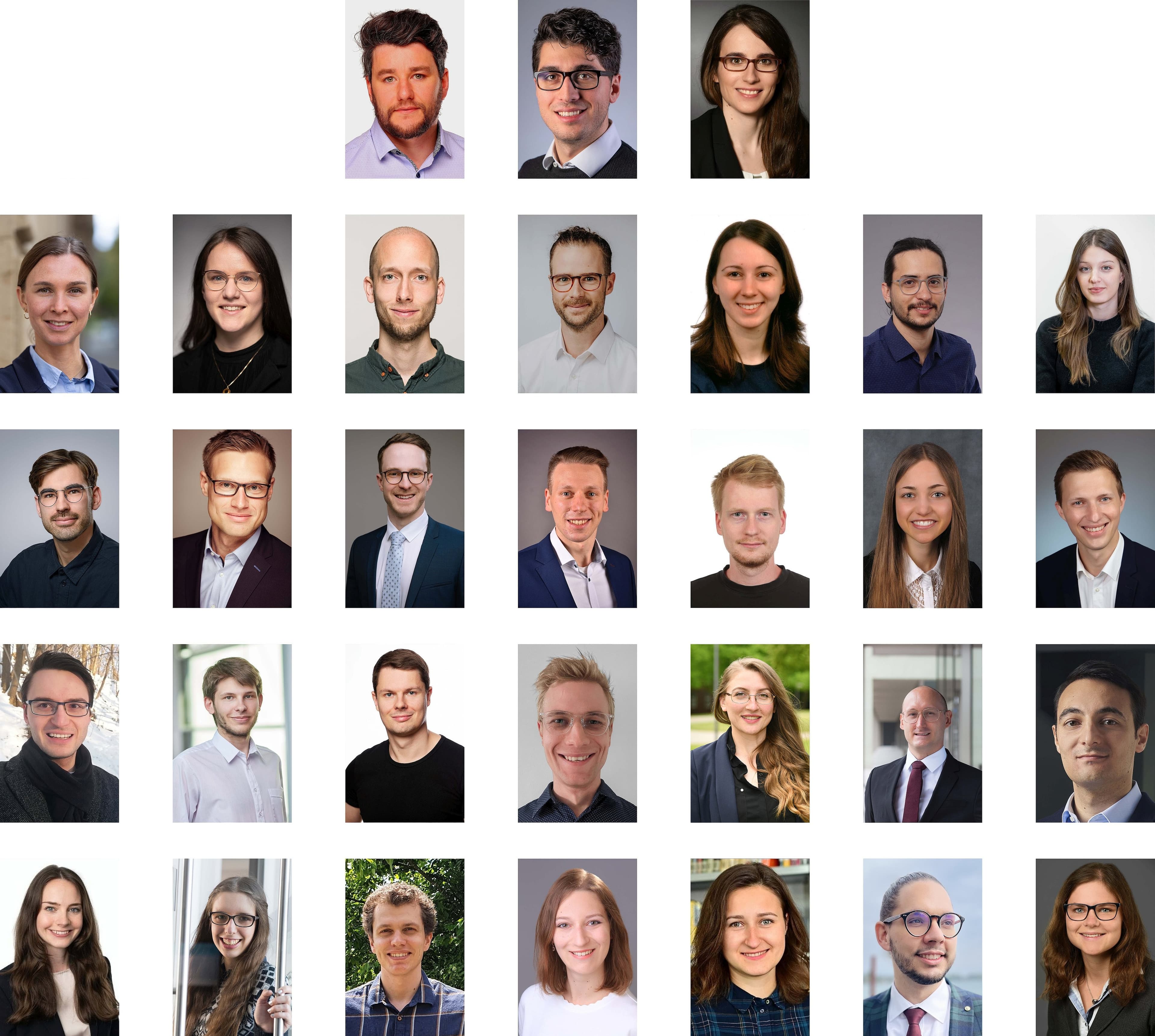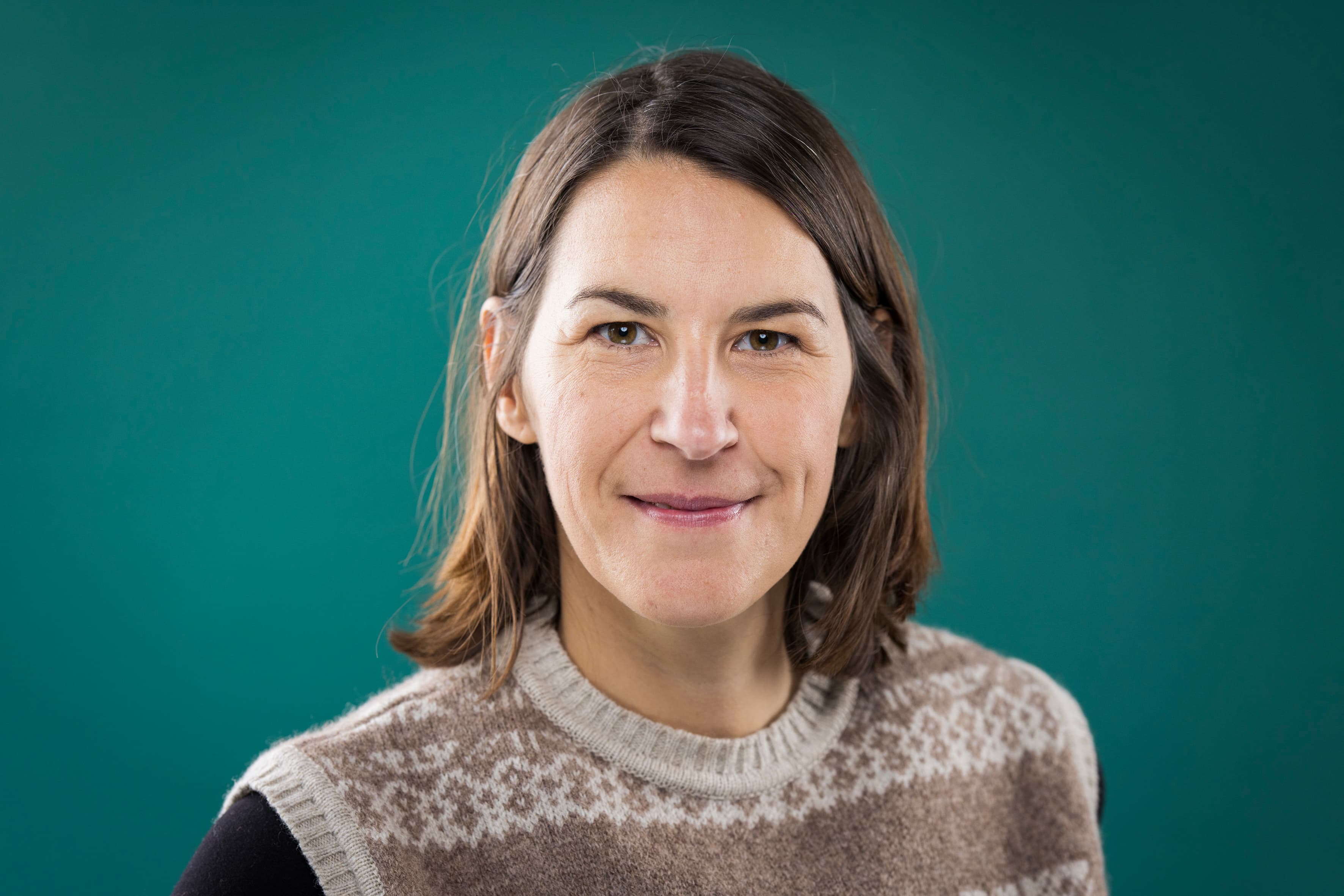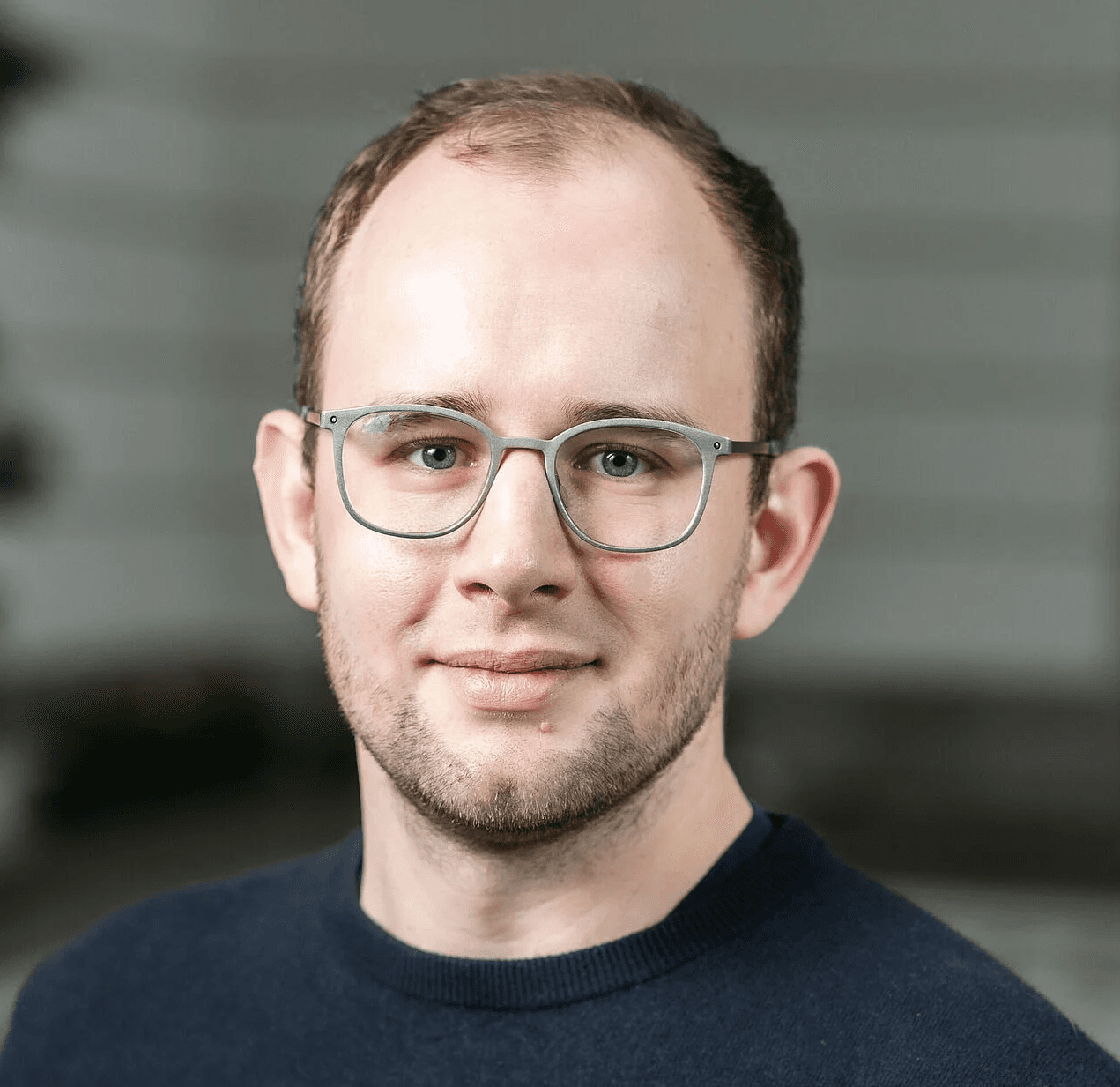1 Who are the GAMM Juniors?
Juniors1https://www.gamm-juniors.de are young academics and members of the Association of Applied Mathematics and Mechanics (GAMM).2https://www.gamm.org The GAMM, founded by Ludwig Prandtl and Richard von Mises in 1922, is an interdisciplinary network for researchers in applied mathematics and mechanics and their related fields.
Each year, about ten early-career scientists are appointed for three years by the GAMM Juniors selection committee. Hence, the GAMM Juniors are a group of currently 31 selected young researchers in applied mathematics and mechanics, see Figure 1. The first Juniors were nominated for the period 2012–2015. The appointment as a Junior is a recognition of scientific achievements and includes free membership in GAMM for the tenure period, as well as the opportunity to engage in the Juniors’ activities.
The Juniors are self-organized and manage a broad spectrum of activities that target the personal and scientific development of young academics, see Section 3. Moreover, every year, the GAMM Juniors elect a speaker team consisting of a speaker, a deputy and a second deputy. The speaker participates in GAMM board meetings, represents the voice of young scientists within GAMM and has further responsibilities within the GAMM.
2 How to become a GAMM Junior?
Typically, each university’s local GAMM representative nominates a maximum of two candidates for the Juniors to the GAMM office by 15 June every year. Since 2024, self-nomination is also possible. The nomination consists of a curriculum vitae and a recommendation of at most two pages each. Out of all nominations, the GAMM Juniors selection committee finally appoints ten candidates.
GAMM Juniors have graduated with exceptional achievements in their final thesis and/or PhD thesis in applied mathematics or mechanics within the last two years of the call and are younger than 32 years on that date. Deviations from this time frame due to inactive periods caused by sickness or maternity leaves are considered.
3 Activities
The GAMM Juniors organize themselves and meet twice a year in person to advance joint projects, network, and exchange scientific ideas. Over the past years, they have developed various projects and events related to the annual meeting and the personal growth of the Juniors.
3.1 Summer School on Applied Mathematics and Mechanics
Each year, the GAMM Juniors organize a Summer School on Applied Mathematics and Mechanics (SAMM), dedicated to a special topic in the field, focusing on current research questions. During the event, participants are introduced to the latest developments in areas of interest to GAMM. The 1st GAMM Juniors Summer School took place in 2014 and was on “Differential-Algebraic Equations – Theory and Control.” Since then, various thematic fields have been covered, including scientific machine learning,shape and topology optimization and materials with discontinuities. The summer school has attracted young researchers beyond Germany, including Austria, France, the United Kingdom, and the Czech Republic, reaching up to 70 participants. This year’s summer school (SAMM (2024)3https://www.gamm-juniors.de/samm-2024 on “Uncertainty Quantification, Stochastic Partial Differential Equations and Risk Analysis” took place at ETH Zürich from 29 July to 1 August 2024.
Being part of the summer school’s organizing team offers young researchers invaluable experience, as it allows them to independently conceptualize a scientific meeting, invite speakers, and develop the program. This format is crucial for learning about cutting-edge research topics, setting impulses, fostering the exchange of ideas, networking among participants, and promoting interdisciplinary communication. For instance, in 2021, a special issue [17th GAMM Juniors’ Summer School on Applied Mathematics and Mechanics (SAMM20). PAMM 20, article no. e202000901 (2021) ] of PAMM (Proceedings in Applied Mathematics and Mechanics) was published for the first time following SAMM, featuring a collection of posters and proceedings edited by the SAMM organization team.
3.2 Accompanying events at the GAMM annual meeting
The GAMM Juniors are organizing a number of activities as part of the GAMM annual meeting. The Pre-GAMM4https://www.gamm-juniors.de/activities/pre-gamm features a scientific segment and a soft-skill course. The scientific segment serves as an onboarding event with introductory lectures held the week before the annual meeting, preparing attendees for the plenary talks. The soft-skill session targets young researchers attending a conference for the first time. Held in the morning before the conference opening, it allows participants to seek advice from experienced experts on topics such as presentation tips, initiating conversations, and creating a personal conference agenda. A particularly well-received format is the YAMM Lunch5https://www.gamm-juniors.de/activities/yamm-lunch – an open discussion during lunch where young researchers can get in touch with the community’s established experts on career planning, work-life balance, networking and more. A poster session is organized featuring current GAMM Juniors to present their research, enhancing their visibility and facilitating discussions with other conference participants.
3.3 The journal GAMMAS
To enhance the visibility of early career scientific contributions, the GAMM Juniors established the online journal GAMMAS6https://www.bibliothek.tu-chemnitz.de/ojs/index.php/GAMMAS (GAMM Archive for Students) in 2018. This platform allows young peers to submit articles, including selected aspects of seminars or theses, providing an early opportunity to publish their initial works and gain insight into the publishing process. The journal is divided into three main categories: research articles,technical briefs, and educational articles.
Research articles and technical briefs are authored by students until one year after graduation (MSc), while educational articles can be authored by students as well as graduated researchers. Submissions in these categories can include detailed experiment descriptions, comprehensive proofs, illustrative negative examples, development and/or experimental validation of models, development of novel analytic or numerical methods, introduction of novel experimental techniques, combination and/or comparison of existing methods, providing introductions to modern topics not yet covered by standard textbooks, and reporting negative results.
The journal is managed entirely by the GAMM Juniors, with the speaker team serving as the editorial board. Each year, GAMM awards the best paper published in GAMMAS, offering a prize of 300 euros, designated for attendance at a scientific event or a research visit. We encourage you to seize this opportunity and motivate your students to submit their contributions to GAMMAS. Guidelines are given on the journal website.6
3.4 Mailing list ‘young-academics-in-gamm’
The GAMM Juniors established the mailing list young-academics-in-gamm7https://mailman.zih.tu-dresden.de/groups/listinfo/young-academics-in-gamm to share information with and from young researchers, including summer schools, workshops, job offers, and GAMM Juniors activities from all over the world. The mailing list is open to all, allowing subscribers to distribute announcements and offers.
3.5 Mentoring program
The Mentoring Program is designed to support the personal and academic growth of the GAMM Juniors through informal exchanges with established members of the GAMM community. The program features one year of one-on-one mentoring, where mentees receive personalized guidance from experienced mentors. This allows established scientists to share their knowledge and insights with the next generation. Mentees benefit from tailored advice on various academic and scientific topics, such as networking, writing grant proposals, work-life balance, scientific outreach, and finding positions in academia. Looking ahead, we aim to expand this program to make it accessible to all early-stage researchers within GAMM, thereby enhancing the support network and fostering the development of young scientists.
3.6 Science communication
The goal of this project is to dismantle stereotypes among students from diverse backgrounds and spark their interest in the exciting fields of mechanics and mathematics. Through targeted communication and educational initiatives, we strive to build a bridge to future generations, collaborating towards a more sustainable and technologically advanced future. Engineering and mathematics, in particular, play a crucial role in achieving a sustainable future, and we are committed to highlighting their importance and potential.
3.7 Knowledge Briefs
Knowledge Briefs are monthly 30-minute online presentations designed to make complex topics understandable for everyone, regardless of their field. Active Juniors select the topics, which are then presented by experts. A subsequent 30-minute Q&A session deepens understanding. Although topics are chosen by current Juniors, the presentations are open to all interested parties, including alumni, who can also submit their topics for selection. The goal is to make knowledge accessible, promote interdisciplinary learning, and strengthen the exchange between current and former members, continuously expanding the knowledge base. For further information, join our Discord channel (see Table 1).
3.8 Fall meeting
The Juniors convene every autumn to thoroughly discuss the current status of ongoing and new projects, as well as to launch new initiatives, and to strengthen social bonds. Additionally, a session dedicated to interdisciplinary scientific talks is scheduled each year to initiate and intensify research collaborations. Most recently, the board of GAMM and the GAMM Juniors took the opportunity of the fall meeting 2023 to directly exchange ideas and discuss current topics within the organization, as well as the development of the Juniors themselves. Newly elected Juniors are integrated into the projects based on their personal preferences, enabling them to actively participate in the projects of their choice. Joint recreational activities round off the fall meetings.
4 Network and impact of the GAMM Juniors
The GAMM Juniors consider themselves as the connecting link between GAMM and the community of young scientists from mathematics and mechanics in Central Europe, and as one of the main driving forces for innovation within the association. The GAMM Juniors develop new ideas and concepts for the benefit of the community and beyond, bring ideas and visions to life to improve the status quo, and promote, motivate, and connect young researchers. The first two of these core missions are realized through the projects of the GAMM Juniors described in the previous section, while the long-term impact within the community is less apparent and therefore more difficult to describe and measure. The GAMM Juniors offer opportunities to engage within the young researcher community with close contact to alumni, forming a dense network of professionals in academia and industry, 61% of whom are male, while 39% are female/diverse. The percentage of Juniors alumni in academia or at research institutes is 74%, while 26% have moved to Industry (see Figure 2).
Kay Henschel
Christian Kielmann
Joining the GAMM Juniors connects you with a dedicated community of young, motivated scientists in the early stages of their careers. Engaging with other GAMM Juniors facilitates discussions about scientific ideas beyond one’s own field of expertise, sharing experiences regarding PhD or postdoc positions, initiating collaborative projects, and building a sustainable network based on mutual support. This fosters interdisciplinary collaborations, such as the joint organization of minisymposia at conferences. Additionally, the projects organized by GAMM Juniors, including the Mentoring Program and the YAMM lunch, offer valuable opportunities to engage with experienced researchers in our community. Being a GAMM Junior also enhances your visibility in the scientific world. Several former GAMM Juniors have achieved notable success in academia, now serving as professors in their respective fields, such as Prof. Dr. Claudia Schillings from the Free University of Berlin and Prof. Dr.-Ing. Merten Stender from TU Berlin.
In conclusion, we believe that the GAMM Juniors provide great ways to engage with young members within the community of mathematics and mechanics. They offer a platform to exchange scientific and non-scientific ideas, making them a key driver of innovation within the GAMM. On behalf of all Juniors, we thank the GAMM for this fantastic opportunity and for the support and trust placed in our projects!
Would you like to meet other young researchers and get familiar with cutting-edge methods in current research before the next GAMM annual meeting? – We look forward to welcoming you at the next Pre-GAMM! Or directly get in touch via juniors@gamm.org or join our discord server,8https://discord.gg/X69uV5xQ67 where we keep you informed and up to date with various developments within our community, providing a space for continuous learning and engagement. Also make sure to visit our pages,9https://www.gamm-juniors.de, GAMMAS: https://www.bibliothek.tu-chemnitz.de/ojs/index.php/gammas, SAMM: https://www.gamm-juniors.de/samm-2024 see the QR codes in Table 1.
Get in contact with the Juniors: visit our website (a), check out GAMMAS (b), join our discord server (c), visit and follow our LinkedIn account (d) and pay the SAMM homepage (e) a visit!
- 1
- 2
- 3
- 4
- 5
- 6
- 7
https://mailman.zih.tu-dresden.de/groups/listinfo/young-academics-in-gamm
- 8
- 9
https://www.gamm-juniors.de, GAMMAS: https://www.bibliothek.tu-chemnitz.de/ojs/index.php/gammas, SAMM: https://www.gamm-juniors.de/samm-2024
References
- 7th GAMM Juniors’ Summer School on Applied Mathematics and Mechanics (SAMM20). PAMM 20, article no. e202000901 (2021)
Cite this article
Andreas Warkentin, Richard Schussnig, Giuseppe Capobianco, Georgia Kikis, The GAMM Juniors. Eur. Math. Soc. Mag. 133 (2024), pp. 51–55
DOI 10.4171/MAG/216




